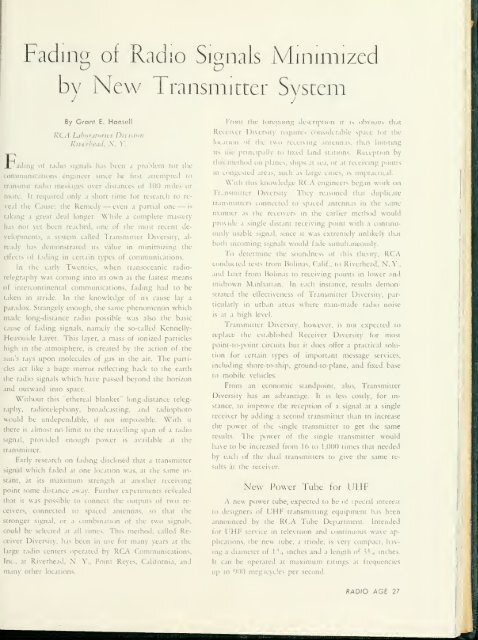Radio Age - 1952, April -34 Pages, 2.9 MB, .PDF - VacuumTubeEra
Radio Age - 1952, April -34 Pages, 2.9 MB, .PDF - VacuumTubeEra
Radio Age - 1952, April -34 Pages, 2.9 MB, .PDF - VacuumTubeEra
- No tags were found...
You also want an ePaper? Increase the reach of your titles
YUMPU automatically turns print PDFs into web optimized ePapers that Google loves.
Fadino- of <strong>Radio</strong> Sitinals MinimizedD t)by New Transniirrer SystemBy Grant E.HonsellFrom the foregoing description it is obvious thatRCA Liborjtorii's Dit isioiiRiterhead, N. Y.jr.Kljng of radio signals has been a problem tor diecommunications engineer since he first attempted totransmit radio messages over distances of100 miles ormore. It required only a short time for research to revealthe Cause; the Remedy — even a partial one — istaking a great deal longer. While a complete masteryhas not yet been reached, one of the most recent developments,a system called Transmitter Diversity, alreadyhas demonstrated its value in minimizing theeffects of fading in certain types of communications.In the early Twenties, when transoceanic radiotelegraphywas coming into its own as the fastest meansof intercontinental communications, fading had to betaken in stride. In the knowledge of its cause lay aparadox. Strangely enough, the same phenomenon whichmade long-distance radio possible was also the basiccause of fading signals, namely the so-called Kennclly-Heaviside Layer. This layer, a mass of ionized particleshigh in the atmosphere, is created by the action of thesun's rays upon molecules of gas in the air. The particlesact like a huge mirror reflecting back to the earththe radio signals which have passed beyond the horizonand outward into space.Without this "ethereal blanket" long-distance telegraphy,radiotelephony. broadcasting, and radiophotowould be undependable, if not impossible. With itthere is almost no limit to the travelling span of a radiosignal, provided enough power is available at thetr.msmitter.Early research on fading disclosed that a transmitterReceiver Diversity requires considerable space for thelocation of the two receiving antennas, thus limitingits use prmcipally to fixed land stations. Reception bythis method on planes, ships at sea, or at receiving pointsin congested areas, such as large cities, is impractical.With this knowledge RCA engineers began work onTransmitter Diversity. They reasoned that duplicatetransmitters connected to spaced antennas in the samemanner as the receivers in the earlier method wouldprovide a single distant receiving point with acontinuouslyusable signal, since it was extremely unlikely thatboth incoming signals would fade simultaneously.To determine the soundness of this theory, RCAconducted tests from Bolinas, Calif., to Riverhead, N. Y.,and later from Bolinas to receiving points in lower andmidtown Manhattan. In each instance, results demonstratedthe effectiveness of Transmitter Diversity, particularlyin urban areas where man-made radio noiseis at a high level.Transmitter Diversity, however, is not expected toreplace the established Receiver Diversity for mostpoint-to-point circuits but it does offer a practical solutionfor certain types of important message services,including shore-to-ship, ground-to-plane, and fixedtomobile vehicles.baseFrom an economic standpoint, also, TransmitterDiversity has an advantage. It is less costly, for instance,to improve the reception of a signal at a singlereceiver by adding a second transmitter than to increasethe power of the single transmitter to get the sameresults. The power of the single transmitter wouldhave to be increased from 16 to1.000 times that neededby each of the dual transmitters to give the same resultsat the receiver.signal which faded at one location was, at the same instant,at its maximum strength at another receivingpoint some distance away.Further experiments revealedNew Power Tube torLlIFthat it was possible to connect the outputs of two receivers,connected to spaced antennas, so that thestronger signal, or a combination of the two signals,could be selected at all time;. This method, called ReceiverDiversity, has been in use for many years at thelarge radio centers operated by RCA Communications.Inc., at Riverhead, N. Y.. Point Reyes, California, andm.inv other locations.A new power tube, expected to be of special interestto designers of UHF transmitting equipment has beenannounced by the RCA Tube Department. Intendedfor UHF service in television and continuous wave applications,the new tube, a triode, is very compact, hivinga diameter of 1 '4 inches and a length of 3' 4 inches.It can be operated at maximum ratings at frequenciesup to 900 megacycles per second.RADIO AGE 27
















